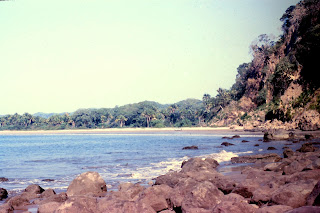Even before I was interested in plants, I had a fascination with the tropics. Fueled by an unhealthy diet of Tarzan books and movies, the Kon Tiki adventures of Thor Heyerdahl, Green Mansions, Mutiny on the Bounty, and countless others, it was all about the mystery, romance and glamour of the fictional tropics. My Dad’s collection of National Geographic Magazines also aggravated my armchair exploration of the jungles of the Amazon, equatorial Africa, and the South Seas. To me a tropical rain forest was a lush, green paradise, in which one frolicked, clad in nothing more than a loin cloth.
I would eventually learn the truth when I began venturing out in search of rare tropical plants (or in search of paradise - probably a bit of both). I found that tropical rain forests are in fact steam baths, with muddy, slippery paths that perversely dump you at every opportunity into clumps of spiny vines. The hostile natural inhabitants include every conceivable stinging, biting insect and venemous snake. But by then it was too late. I was hooked on tropical plants, particularly palms, and would later spend many years studying them.
The tropics of western Mexico were a day’s drive from my home in southern California, and my Dad decided to drive me down the coast one winter break when I was in high school. Later, I went down a couple of times more with friends from college. These trips, and photos I'm sharing with you were all done in the 1960's, so things have undoubtedly changed since then. I suspect that the rain forests are gone and the beaches of San Blas are lined by resort hotels. A quick trip via Google Earth confirms the latter. Some of the hilly areas still look pretty green, but I cannot confirm the status of the forest.
 |
| In southern Arizona and northwestern Mexico, the Sonoran desert vegetation consists of xerophytic shrubs and the abundant cholla cactus, Cylindropuntia echinocarpa. |
There is a gradual transition from there into progressively lusher vegetation. Around the coastal town of Guaymas, a type of thorny scrub vegetation covers the hillsides. After winter rains, wildflowers like morning glory and passionflower can be found among the shrubs.
 |
| Near Guaymas, a lusher desert vegetation covers the hillsides. |
 |
| An organ pipe cactus, Stenocereus thurberi (or related species) is surrounded by grass that grew lushly during the previous summer. |
 |
| An unidentified epiphytic cactus in the dry forest of western Mexico. |
 |
| A hardy, epiphytic orchid in the decidous tropical forest. |
 |
| The tree morning glory, Ipomoea arborescens, blooms after its leaves fall in the dry season. |
 |
| Epiphytic bromeliads survive on the branches of a Ficus tree in the deciduous tropical forest. |
 |
| A yellow-flowered Tabebuia blooms in the deciduous forest during the dry season. |
 |
| Sabal rosei palms are common in northwestern Mexico. |
 |
| A Philodendron clings to a tree trunk in the rain forest. |
According to the vegetation maps, it’s supposed to be the same - dry deciduous forest - all the way down to the southern part of Mexico. So it was quite a surprise to descend into a Pacific-facing valley near the town of San Blas and find the hillsides covered with a lush tropical rain forest. Giant trees, probably related to the kapok tree, dominated the forest, but there were an extraordinary number of giant Attalea cohune palms as well. Strangler fig Ficus trees, woody lianas, and large leaved Cecropia saplings were common as well. In the forest, philodendrons of several types climbed on the trees and exotic butterflies were everywhere. Whether this is technically a true rain forest, I'm not sure, but it is evergreen, and surely a Tarzan-worthy jungle. Butterflies were another of my interests at the time, and a number of them ended up skewered by mounting pins in my collection box.
 |
| The road from the highlands down to the coastal town of San Blas winds through an evergreen tropical rain forest. |
 |
| Cecropia saplings, with their large, umbrella-shaped leaves, dominate an open ravine in the rain forest, while large Attalea cohune palms rise on either side. |
 |
| A strangler fig and lianas compete for canopy space in the rain forest. |
 |
| Barleria micans blooms at the base of coastal cliffs near San Blas. |
 |
| The coastline near San Blas was wild and little-visited in the 1960's |
Tropical Mexico introduced me to many other delights, the most memorable to me being the delicious platano manzano, the apple banana. Though tropical, the rain forest around San Blas was far enough north to be a bit cooler and drier than the rain forests I would later encounter in more equatorial forests. So it wasn’t quite the bug-infested sauna that it could be, and it only enticed me to continue my explorations later in Costa Rica, Ecuador, and most of all Papua New Guinea, where I had the privilege to work for more than a year.
 |
| A girl does her laundry under a spreading Bouganvillea vine in the town of San Blas. |
 |
| Datura vines (Tomato family - Solanaceae) spread across the sand near one of our camps. They are relatives of the Jimson weed, a source of hallucinogenic drugs. |